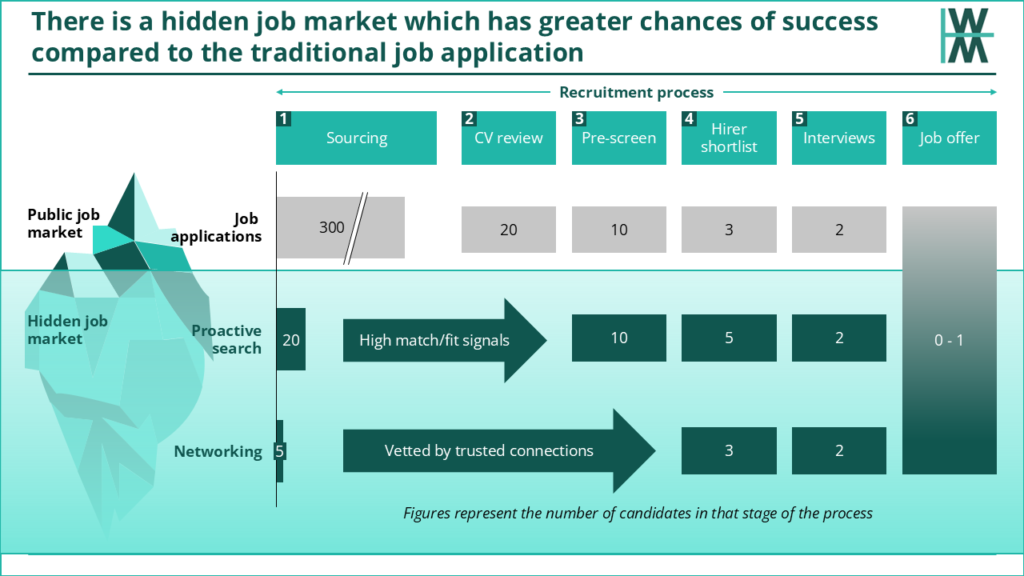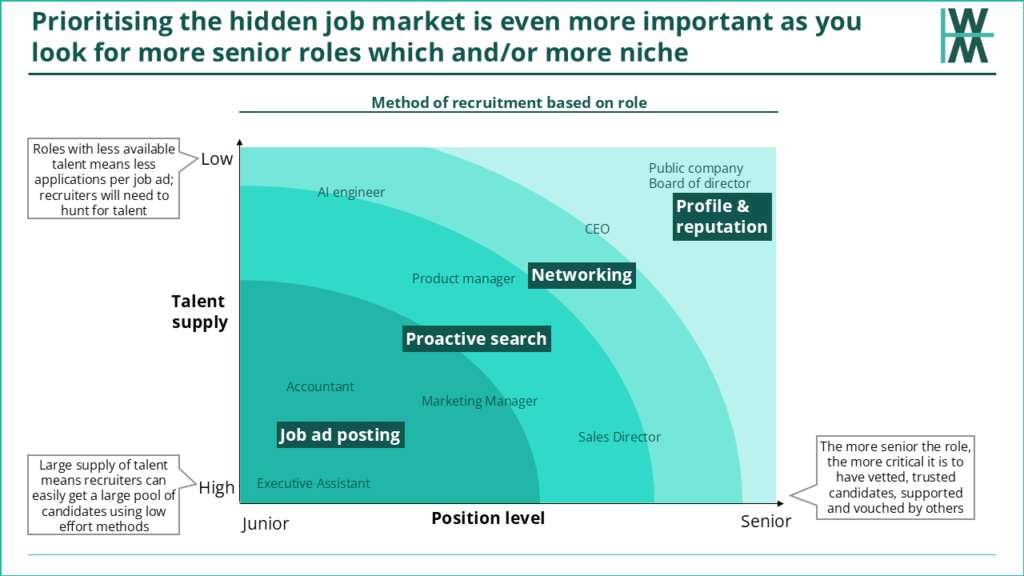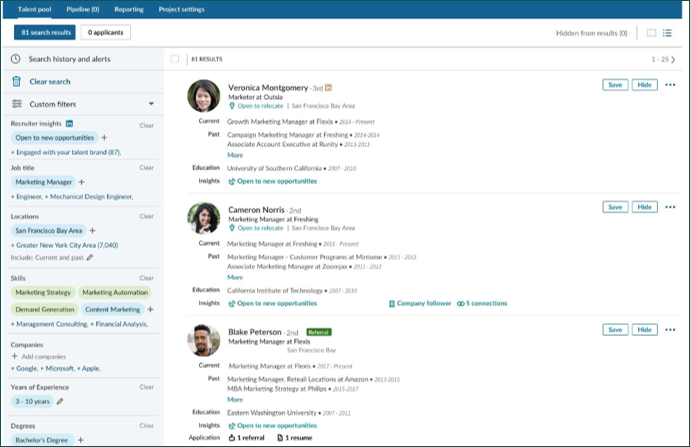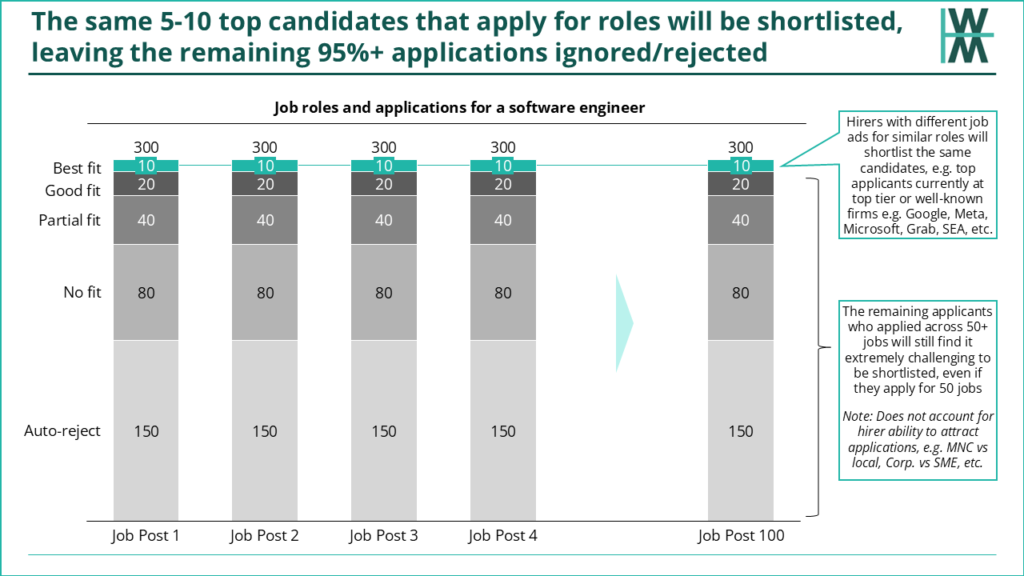First-rate people hire first-rate people; second-rate people hire third-rate people
Leo Rosten
Welcome back to another post in my Salary Series! In my previous post, I wrote about negotiating salaries for a new job offer. But how do you go about getting those job offers in the first place?
That’s where Parts 5 (this post) and 6 come in, where I delve into the dynamics and how to job search. In this post, I’ll explain in detail the dynamics of the employment marketplace and debunk myths that persist despite lacking credible evidence (I blame online content, which often reinforces these myths without substantiation). In the next post (Part 6), I’ll reveal some new meta strategies that will help you best the competition in the job search.
If you need to know my credentials on this topic:
- Almost 20 years in the workforce, with some experience in the employment marketplace and its tech platform(s)
- Over 15 years of experience as an interviewer or hiring manager, and
- Headhunted numerous times for senior roles (up to C-suite roles), and also received offers at top-tier global firms.
Before I dive into the practical steps for the job search, I’m going to go through some theory. Let me share with you how the employment marketplace works, particularly from the employer/recruiter’s point of view.
Disclaimer: Again, there are generalisations in this post. What I describe in this post will skew towards the large corporations. Smaller firms and SMEs may simplify or skip some of these steps.
The dynamics of the employment marketplace
The employment marketplace is easily the most interesting and complex aspect of the labour market. When people think of recruiting and the job search process, most people will think of the traditional method of finding jobs, which is:
1. Post and Pray
When a company needs to find suitable candidates (externally), the HR team will post a job advertisement on its own company’s career portal, as well as external job portals such as JobStreet by SEEK (in Malaysia) and LinkedIn. Candidates search for and view job advertisements, and subsequently submit applications with their CVs.
This is the traditional method to apply for jobs. But do you know what happens afterwards from the hirer’s perspective?
- For many job opportunities, there are hundreds of candidates applying, assuming the opportunity is for a well-known corporation
- Many of these candidates aren’t even a partial fit for the role, but they still apply. Many are just spamming or just trying their luck. The reality is that ~90% or more of applications aren’t even a passable match to the job requirements (yes, you are also very likely to be a part of that statistic)
- Applications are typically recorded in a digital database with an application search function and workflow tool. These are called Applicant Tracking Systems (ATS)
- Because of the sheer volume of applications, most hirers will have to be ruthless. As there is no way to efficiently review hundreds of applications, hirers will use a search filter with strict keywords to come up with, say, a shortlist search result of about 20 applications
- An example of strict keyword/matching criteria would be as follows:
- A close match in job titles
- Minimum number of years of relevant experience
- Location (being in the same city)
- Specific technical words like SQL, Kubernetes, CPA, JavaScript, Python, fintech… No generic keywords, such as communication, leadership, team player, problem solving (everyone has those in their CV)
- All other applications remain “invisible and hidden” as an unreviewed application in the ATS. Don’t believe me? Look up Boolean Search in Recruiting.
What does this mean? This means that only candidates with the best fit, working in the best brand-name companies, with the most years of experience, will be shortlisted for interviews. (This will vary depending on the quality of the candidate pool; if the hirer is a relatively unknown SME, the hiring standards will be lowered to anyone who is “good enough” or a “good fit”)
That’s the unfortunate truth of the matter. Even then, sometimes the best-fit candidates may end up having their resume lost in the avalanche of applications, which may never see the light of day by a human.
Is there a better (and less demoralising) way to find job opportunities?
2. The hidden job market
Yes, there is, in fact, a hidden job market hiding in plain sight. Companies may choose to find eligible candidates using two other methods in the hidden job market, as shown below:

1. Proactive search: Have you ever received a message on LinkedIn or JobStreet by SEEK, from someone in a Talent Acquisition team or a recruiter asking you if you might be interested in a job opportunity? That’s proactive search.
For a typical job advertisement, timing matters. Hirers hope the best candidates stumble across the job ad within the time period when it is live (typically 30 days). On many occasions, it requires a lot of luck for right-fit candidates to chance upon the job ad. Or, the job opening might be confidential in nature. Or, it requires poaching top talent who are currently employed somewhere else, who may not be actively searching for a new job.
In these instances, many companies take the initiative to search employment platforms for suitable profiles and reach out to them. They may use their own hiring team, an a third-party recruiter to conduct the proactive search.
2. Networking: Ever had friends try to refer you to a job opening at their employer so they can earn a referral bonus? Or have you heard of someone being recommended to a hiring manager as the best person for the job? Many opportunities are actually filled through a recommendation from a friend, family member, colleague, or even ex-colleague.
In fact, the hidden job market thrives on networking. The best jobs, if hired externally, usually come from someone who knows someone. Or, through networks and connections, an entirely new position is created to accommodate someone who was introduced through networks. You just don’t hear about it happening because it’s not advertised.
3. When hirers use the hidden job market
For both candidates and hirers, the hidden job market, comprising both proactive search (known as headhunting in the old days) and networking, is far more effective than traditional job advertisements.
- For candidates, you “skip the queue”, being the mass job application pool. Your fit and potential candidacy are based on a summarised profile or someone whispering in the ear of the hiring manager. It’s not going to be buried in a sea of candidates
- For hirers, candidates sourced from the hidden job market are usually a better fit. There are stronger signals of competence with the credibility of a referral via networks/connections, and generally, using proactive search narrows the field to be filtered based on better matching of candidates to the hirer’s specific search criteria
Hirers don’t always rely on the hidden job market. Typically, hirers use a “post and pray” job ad for lower-end roles and incorporate more proactive sourcing and networking for more senior roles. For the most public-facing and externally visible roles, the highest-profile candidates with an existing public reputation would typically attain the most senior jobs, such as CEOs or directorships in publicly listed companies. It’s a combination of two factors; supply of talent and how senior the position is.
The diagram below shows how candidates are typically sourced depending on the role:

The less available supply of candidates, the harder it is to find candidates “out in the wild”, and hirers will have to search for them actively. The more senior the role, the more confident the hirer needs to be in making the right choice (and having others vouch for a candidate is a strong signal of fit and competence).
4. Current and future trends
In the past few decades, there have been two seismic shifts in the employment marketplace, and both are the result of the internet:
- Online distribution channels, i.e. online job boards, which have significantly increased the reach and exposure of candidates with job opportunities (and also, the level of competition); and
- Public candidate profiles, which have enabled efficient proactive search by recruiters and hirers for more junior positions (meaning, headhunting doesn’t just apply to senior executive/c-suite roles anymore)
What about the future of the employment marketplace? Some emerging trends are:
Remote work. Post-COVID, hirers are more open to remote workers. The ability to apply for and work in jobs from anywhere in the world means that not only means increased opportunities, but also increased competition. Not only do you have more job opportunities available to you, but more candidates from all over the world could be applying for the same job as you are
Generative / Large-Language Models (LLMs). Candidates are beginning to hyper-customise CVs and cover letters for each job advertisement. But like I mentioned above, everyone’s doing this, so no one’s profile actually “stands out”, and everyone has the same keywords. In addition, no amount of hyper-customisation is going to help against a candidate that is not a good fit, i.e. lacks sufficient experience. You can’t lie about your profile to match the hard requirements the hirer is looking for in a candidate
Agentic AI tools. Currently extremely nascent. The idea with these tools (still mostly conceptual in nature) is that they ease and automate application and hiring processes. If these tools are effective and reach a tipping point, there will be less “friction” to apply, meaning there will be a lot more spam and noise. Applications per job ad may increase from hundreds to the thousands, and hirers will have to be even more ruthless with the shortlisting process.
Dispelling job search myths
It is very frustrating when myths about the job search persist, and many people still parrot these myths without any proof or any experience in the industry. I’m here to dispel them.
Again, bear in mind this mainly applies to corporate jobs. If you work in non-typical corporate jobs, some of this information may not apply to you.
Some of these are going to be harsh truths and may be difficult to swallow. Let’s shatter some mirrors.
The job market is flooded with fake ads created by companies to give the illusion they’re growing and hiring. Many are convinced of this because they’ve applied for 500 jobs and received zero responses, and have seen some companies reposting the same generic job ad for 6 months in a row.
The truth is, yes, some companies post fake job ads. But it isn’t the majority.
When is this myth true (being a “fake” job ad)? Well, aside from the likely small minority of “fake job ad” by hirers, other reasons are:
Some job advertisements you see are known as evergreen postings and are legit (Google it). For example, a large grocery chain may have a permanent job ad to hire for checkout staff, as they need to constantly replace staff attrition that is occurring across all their stores.
Also, if the job ad is from a recruitment firm, there may be a higher chance that it is “fake” as they aim to farm CVs (because they may very frequently get mandates to hire for similar roles, so they might as well have an evergreen posting). That can be a good thing because they may find your profile a match for a future job opportunity (albeit a bit sneaky).
For some employment marketplace platforms, the ad may be a “scraped copy” of an actual job ad from another employment platform or company career portal. That’s how smaller players try to show their platform is “bustling with ads” and “alive”. The lesson here is, stick to the large, credible employment platforms.
But also, maybe, just maybe, you’re not getting responses because you believe the myth that…
Hirers review every application that comes in, even if it’s just glancing at your CV for 6 seconds. It is somewhat true that hirers/recruiters may only spend 6 seconds reviewing your CV. But here’s the reality:
- Hirers only look at a small proportion of applications
- Of that small proportion, only a smaller proportion of CVs are reviewed, if your application “matches the Boolean Search” AND “fits the key role requirements” (see what I did there? I can use puns)
I’ve explained in the marketplace dynamics section that hirers use Boolean Searches to minimise the number of applications they need to review. The search result then displays a “top-level summary” profile of your application. I took a screenshot from LinkedIn’s online guide to show what it looks like:

Most other ATSes use very similar search result interfaces. That means, search results display very minimal information, e.g. your name, your current position and tenure, and the most recent 1-2 past job positions. And that’s about it.
The screenshot above shows 81 results. That’s too many. So there’s going to be another round of adding stricter criteria to the search filter, perhaps increasing the minimum number of years of experience. Or requiring fintech experience.
Only once there’s a shortlist of say, fewer than 30 results, would a hirer start opening applications/profiles and reviewing CVs (the number and behaviour is obviously subjective).
Hopefully, what I’ve explained above also dispels the myth that…
You need to beat the ATS. ATS systems are basically digital databases and workflow tools to help HR standardise applicant information, manage and track applications for each job advertisement. That’s pretty much it.
Wait, you say you saw YouTube videos and blog posts about how you need to customise your CV with keywords that match the job description, or hide AI prompts to hopefully trick the ATS into “passing your CV”?
Yes, ATS systems do have ranking/scoring systems or magic AI matching tools as a feature to help hirers rank applications; however, no recruitment team I have ever encountered actually ever uses it
Why?
- They’re too basic, not fit for purpose and too standardised. Best fit is subjective and specific to the job requirements and needs of the hiring manager for the role
- These ranking features are black boxes, meaning recruiters can’t see behind the curtain to understand how they work. There are changes of false negatives (missing out on a good candidate), so hirers are not going to want to take their chance
- “Everyone” is already uploading their CVs and job advertisements into LLMs to “customise their CVs”. Guess what? Everyone has the same keywords and phrases to “beat the ATS”. So if true, the AI in these ATSes are meaningless
- And because the typical job application has hundreds of candidates, the Boolean Search feature is usually good enough to get a decent shortlist of candidates
This may change as AI capabilities advance, but there may always be an element of hirers falling back to more deterministic and predictable solutions, such as Boolean Search and direct filters.
That leads to the most interesting myth (or rather, misunderstanding), which is the widespread belief that…
If you apply for 100 jobs, you should statistically receive at least 1-2 calls from HR/recruiters. Even if you apply for 5,000 jobs and you believe you’re a good fit, it still can be quite likely that you may not get more than a handful of responses, or any at all.
In theory, the myth is statistically right. However, in practice, probabilities of more responses may not result from more applications. The employment marketplace operates similarly to a “winner takes all” market.
What does that mean? Another way to think about it is that job opportunities (or even shortlisting) follow the Pareto distribution. The candidates with the best and most attractive profiles will get all the candidates.
Hopefully, the chart below might explain it a little bit better. Let’s assume the role you’re looking for is a software engineer.

You might think you’re a good fit, having 5 years of working experience in mobile app development at a bank. However, there are likely many other applicants with better profiles than yours (If your profile was the best fit, you likely wouldn’t be struggling to get shortlisted, and you’d be constantly getting DMs from recruiters).
For example, Software engineers working at Google or Grab, doing open source projects on the side, who studied at MIT. These profiles get all the opportunities in a “winner takes all” market.
If these “best fit” candidates are applying for the same 100 jobs as you are, you’re in a tough spot. If these 100 Hirers only need to shortlist and interview perhaps 10 candidates (out of say 300 applications), there’s a high chance the majority, if not all of the 100 hirers, will shortlist the same top 10 best fit candidates.
So even good candidates may not get shortlisted.
Obviously, each hirer and each role requirement might be slightly different, but on the aggregate whole, I hope you get the point.
Sidenote: What do I mean by “no fit” and “auto-reject” applications?
- No fit: You’d be surprised how many people that has zero relevance to the job opportunity still apply. I’ve had marketing executives, chefs, department heads, project managers and salespeople all apply to the same job opportunity.
- Auto-reject: Ever had to answer some questions on a job application, such as “Do you have work rights for this country?” or “Do you have at least 5 years of work experience in technical sales?”. These are called pre-screen or auto-screen questions. If you don’t pass these questions but still submit the application, you’re going to get auto-rejected. These questions are there because they are mandatory criteria for the job.
So that leads me to dispelling…
The many, many myths about CVs (and maybe some of them are my pet peeves as a hiring manager)
- You should customise your CV for the job
- This is not what you think it is. I bet you think using the same keywords as the job description to customise your CV for that job opportunity is going to help you? What keywords? Leading projects? Problem solving? Communication? No. Customising your CV means omitting all irrelevant content (e.g. that part-time job at McDonald’s when applying for an accounting job) and highlighting experiences and achievements that match the job requirements
- Also, I already explained earlier about how everyone is using the same LLM tools to customise their applications to the job requirements. Your CV is not going to be special, or even looked at, if you’re not the best (or good) fit candidate (in my next post, I’ll write about what is the better strategy to customise your CV)
- Having a career objective
- Look, the hirer knows your real objective is to make money.
- Colour CVs
- Unless you’re a creative designer, hard pass. There are more downsides than what you think are upsides. Legibility and simplicity are king
- Including a profile photo or picture
- Are you applying for an acting job?
- Having a generic skills section
- Spamming more generic, meaningless words? Anyone can write anything down in the skills section
- Rating your generic skills
- Your Excel skill level is 8/10 or advanced? Uh… no. Just no
- More than 2 pages
- Hirers struggle to even read 1-page CVs properly. There is no reason to go above 2 pages. Ever
Just follow this Harvard guide on CVs and use their template, or something similar. Simple, clean and easy to read. If it works for Harvard graduates, it will work for you.
And finally, the last myth:
Networking is dirty and insincere. If you think networking is about going to a conference or event and distributing your business card, that’s not how it works. In my next post, I’ll talk more about practical steps to network.
Closing thoughts
If you’ve read this far, you might feel overwhelmed by how the job search can be so daunting. It’s not going to get easier. With new technologies, there will be more candidates and more noise in the employment marketplace.
So how do you beat the competition and stand out in the evolving employment landscape? You’re going to need new meta-strategies, and bread & butter job applications, and answering cookie-cutter interview questions isn’t going to cut it.
You’re going to need to approach it with a whole new meta. And that’s what I’ll be covering in my next post.
Stay tuned!



